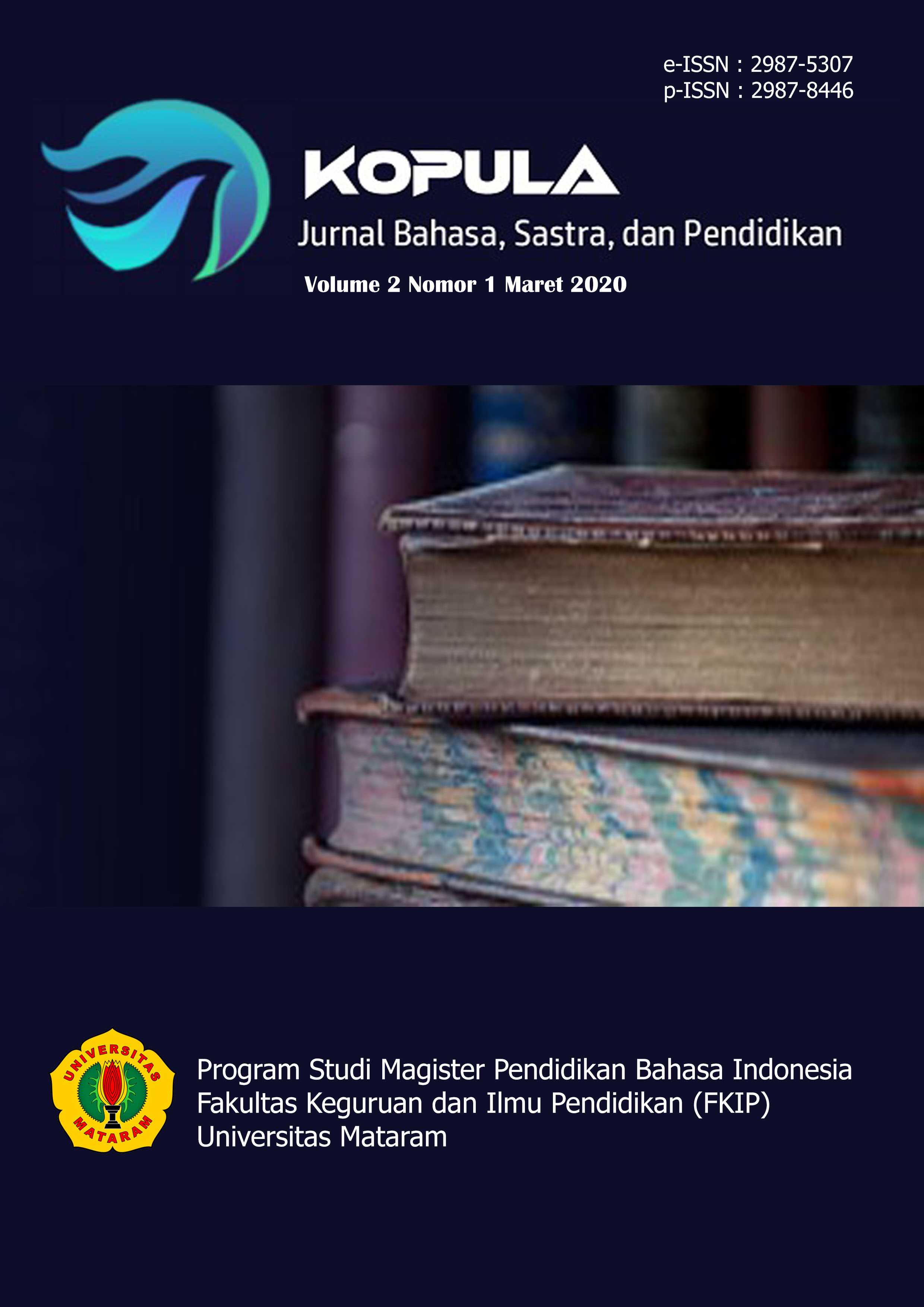Citra Perempuan pada Novel Cinta dalam Diam Karya Shineeminka: Kajian Kritik Sastra Feminis Liberal
DOI:
https://doi.org/10.29303/kopula.v2i1.2732Keywords:
cinta dalam diam, citra perempuan, kritik sastra feminis liberalAbstract
Abstrak
Penelitian ini bertujuan mendeskripsikan citra perempuan yang terdapat pada novel Cinta dalam Diam karya Shineeminka menggunakan kajian kritik sastra feminis liberal. Metode yang digunakan adalah metode kualitatif bersifat deskriptif. Data yang dikumpulkan berupa teks novel yang memuat citra perempuan dalam novel Cinta dalam Diam. Data dikumpulkan menggunakan metode observasi dan studi Pustaka Teknik catat. Tahapannya adalah mengidentifikasi, mengklasifikasi, menganalisis, dan mendeskripsikan citra perempuan pada novel Cinta dalam Diam menggunakan kajian kritik sastra feminis liberal. Hasil penelitian ini, yaitu citra perempuan meliputi citra diri dan citra sosial. Citra diri perempuan terdiri atas aspek fisik dan psikis, sedangkan citra sosial terdiri atas citra perempuan dalam keluarga dan citra dalam masyarakat. Gambaran citra perempuan dari aspek fisik didasarkan pada ciri muka, keadaan tubuh dan perempuan dewasa dalam novel ini digambarkan sebagai sosok yang cantik dan sudah dewasa. Gambaran citra perempuan dari aspek psikis yaitu sebagai makhluk yang berperasaan, berpikir, dan beraspirasi. Gambaran citra dari aspek sosial, yaitu perempuan dalam keluarga sebagai anak, istri, ibu, dan anggota keluarga. Adapun Gambaran citra perempuan dalam masyarakat, yaitu yang berpendidikan, dalam bidang pekerjaan, serta sebagai anggota masyarakat
Abstract
This study aims to describe the image of women found in Shineeminka's novel Cinta Dalam Diam using liberal feminist literary criticism. The method used is descriptive qualitative method. The data collected is in the form of novel texts that contain the image of women in the novel Cinta Dalam Diam. Data was collected using the method of observation and the study of technical literature notes. The stages are identifying, classifying, analyzing, and describing the image of women in the novel Cinta Dalam Diam using liberal feminist literary criticism. The results of this study, namely the image of women includes self-image and social image. The self-image of women consists of physical and psychological aspects, while the social image consists of the image of women in the family and the image in society. The image of women from the physical aspect is based on facial features, body condition and adult women in this novel are described as beautiful and mature. The description of the image of women from the psychological aspect is as beings who feel, think, and have aspirations. Image description from the social aspect, namely women in the family as children, wives, mothers, and family members. As for the description of the image of women in society, namely those who are educated, in the field of work, as well as members of society
Downloads
Published
Issue
Section
License
Authors who publish with Kopula: Jurnal Pendidikan dan Bahasa, agree to the following terms:
- Authors retain copyright and grant the journal right of first publication with the work simultaneously licensed under a Creative Commons Attribution 4.0 International License (CC-BY License). This license allows authors to use all articles, data sets, graphics, and appendices in data mining applications, search engines, web sites, blogs, and other platforms by providing an appropriate reference. The journal allows the author(s) to hold the copyright without restrictions and will retain publishing rights without restrictions.
- Authors are able to enter into separate, additional contractual arrangements for the non-exclusive distribution of the journal's published version of the work (e.g., post it to an institutional repository or publish it in a book), with an acknowledgment of its initial publication in Kopula: Jurnal Pendidikan dan Bahasa.
- Authors are permitted and encouraged to post their work online (e.g., in institutional repositories or on their website) prior to and during the submission process, as it can lead to productive exchanges, as well as earlier and greater citation of published work (See The Effect of Open Access).










